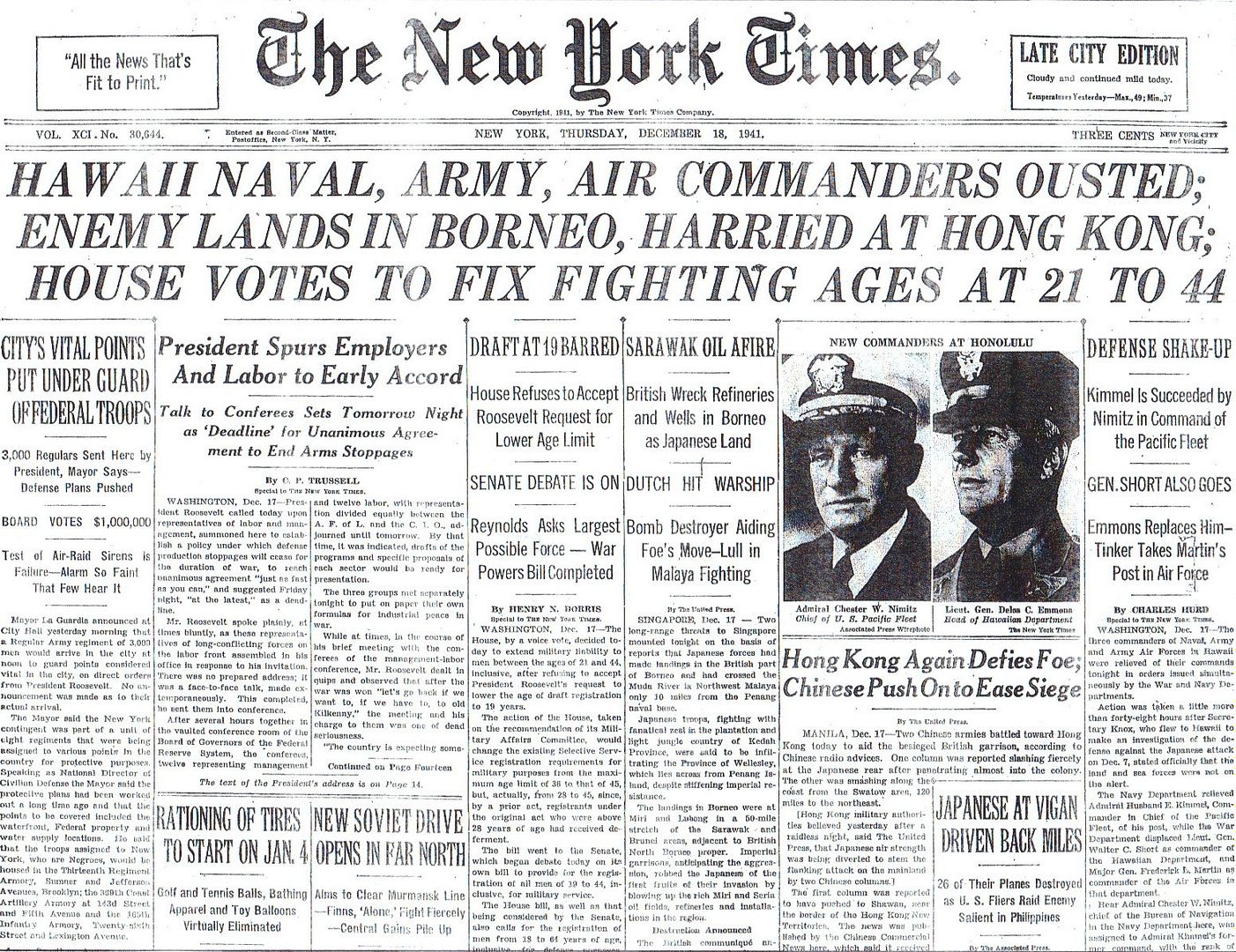
Posted on 12/18/2011 6:42:56 AM PST by Homer_J_Simpson

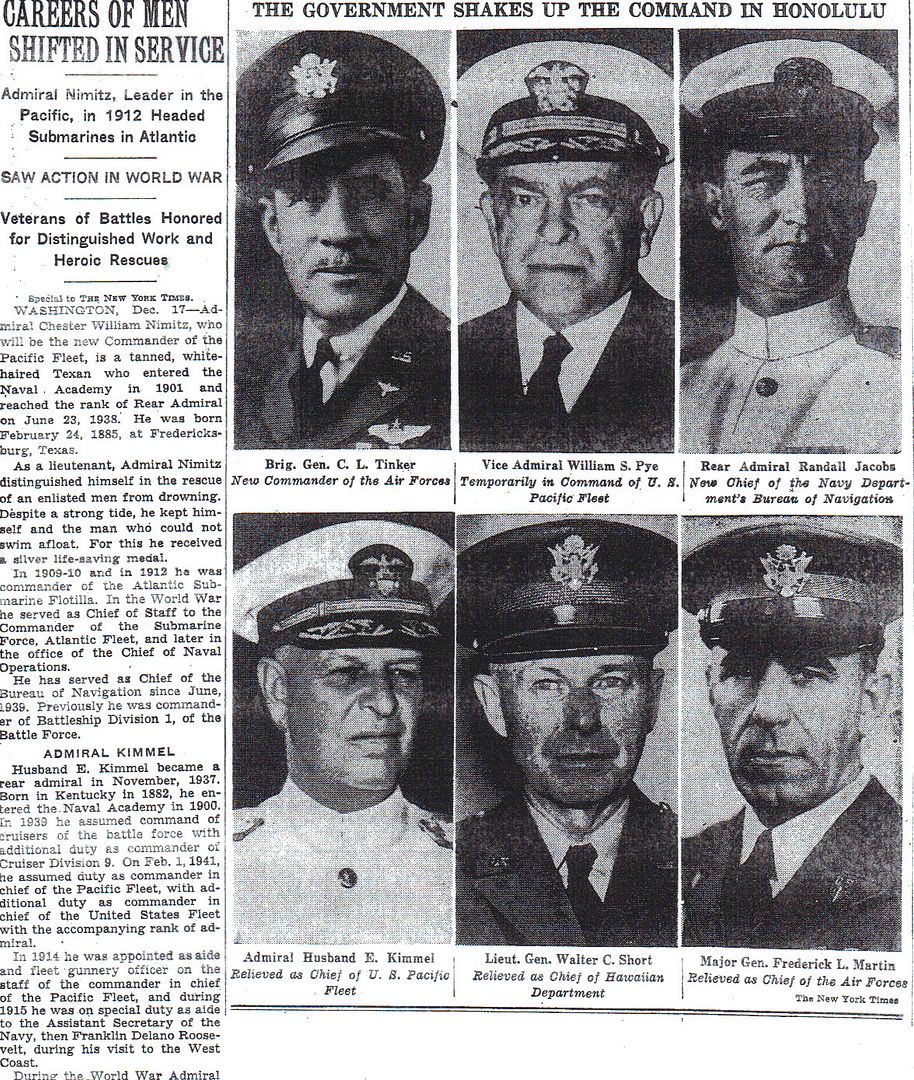
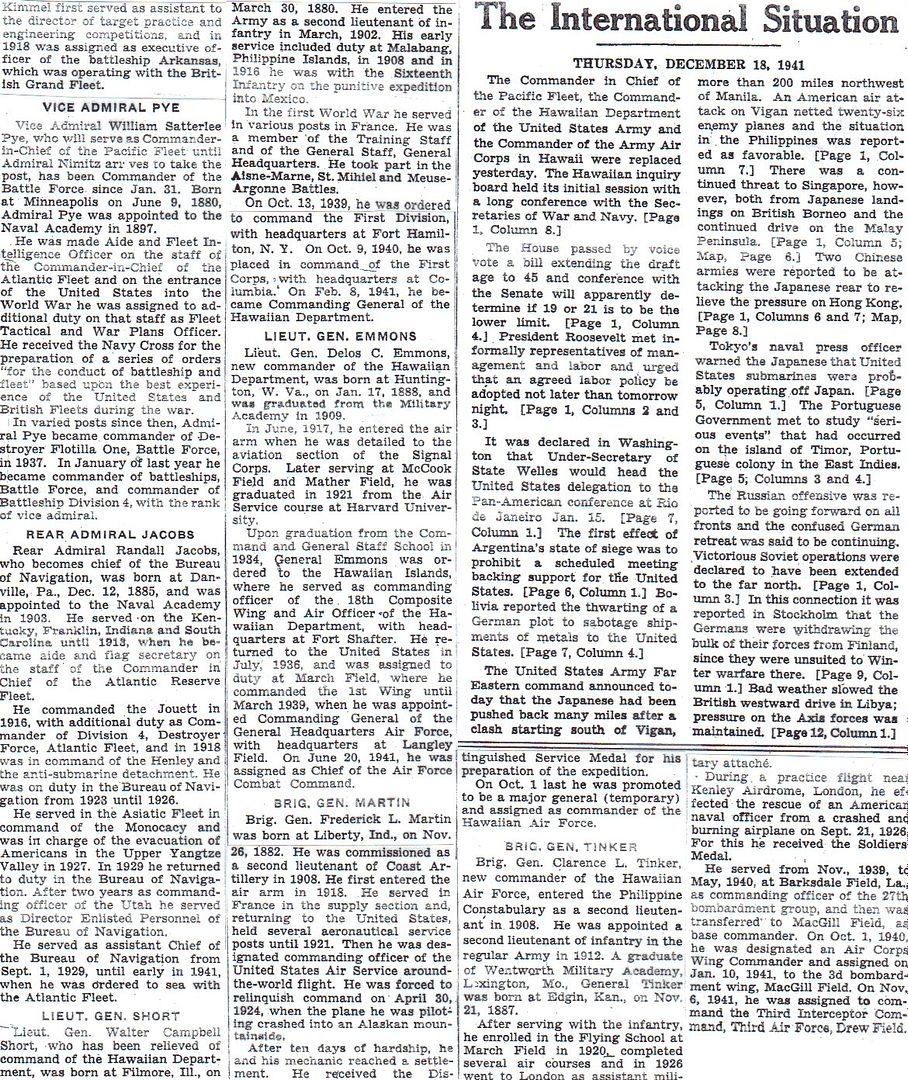
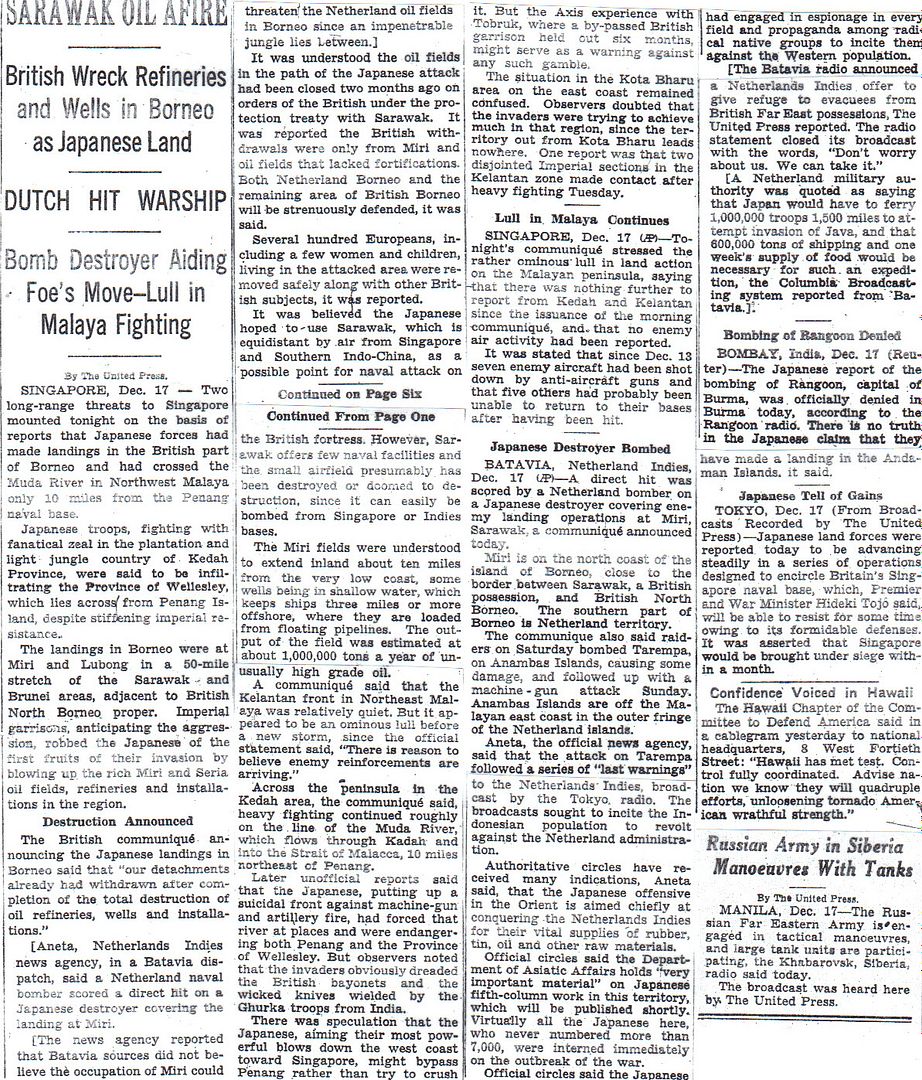

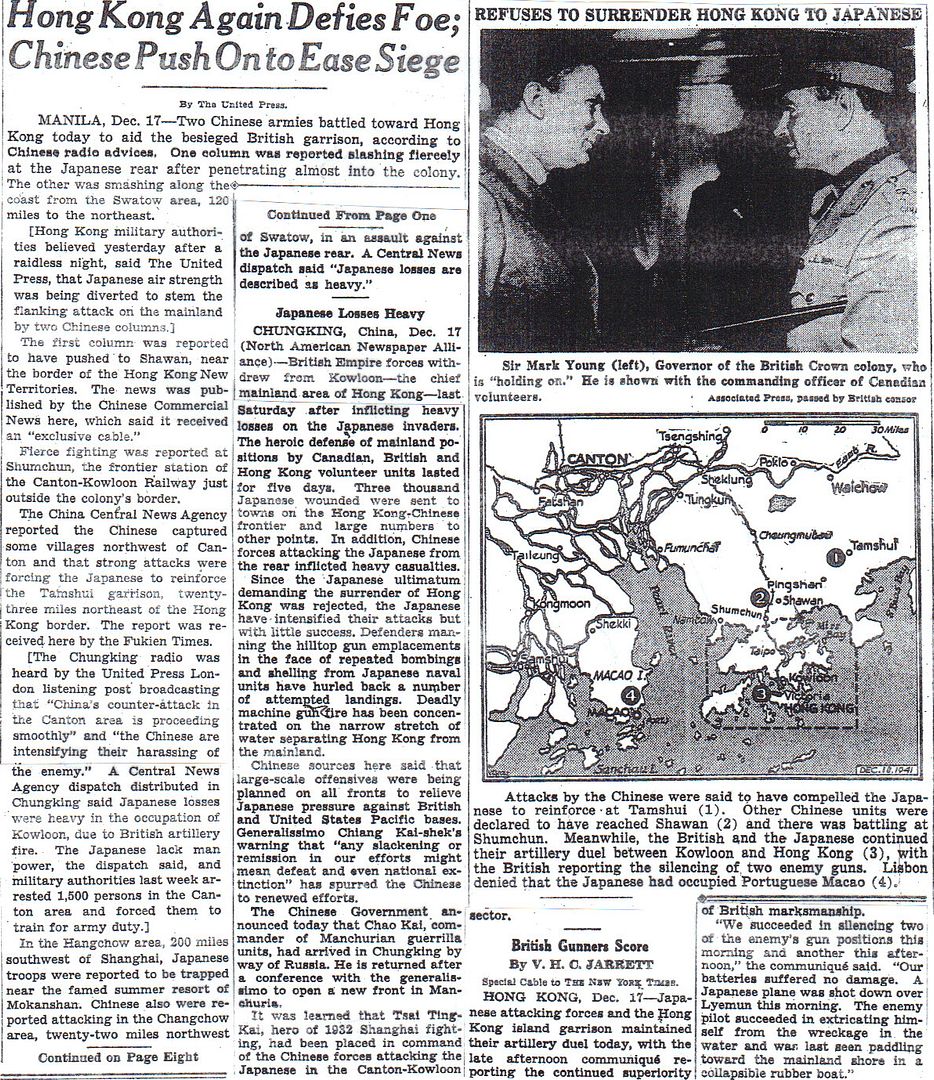
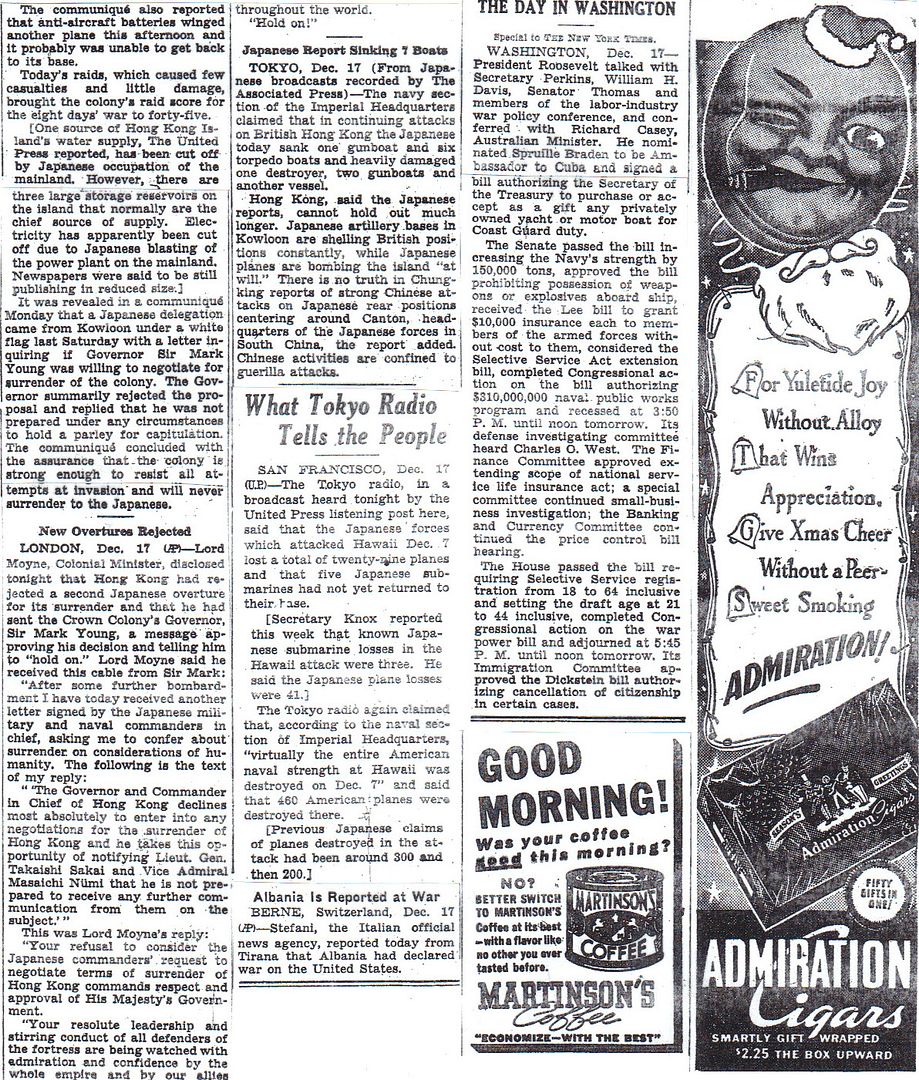
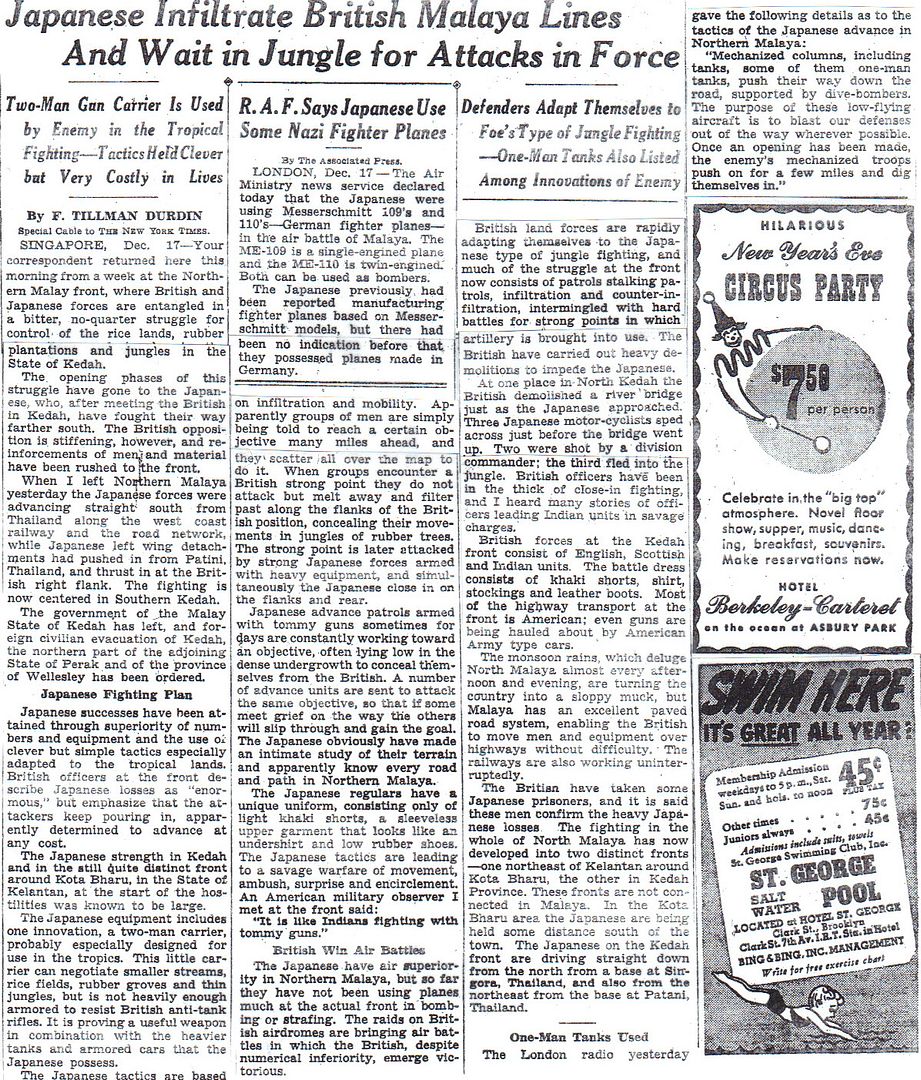
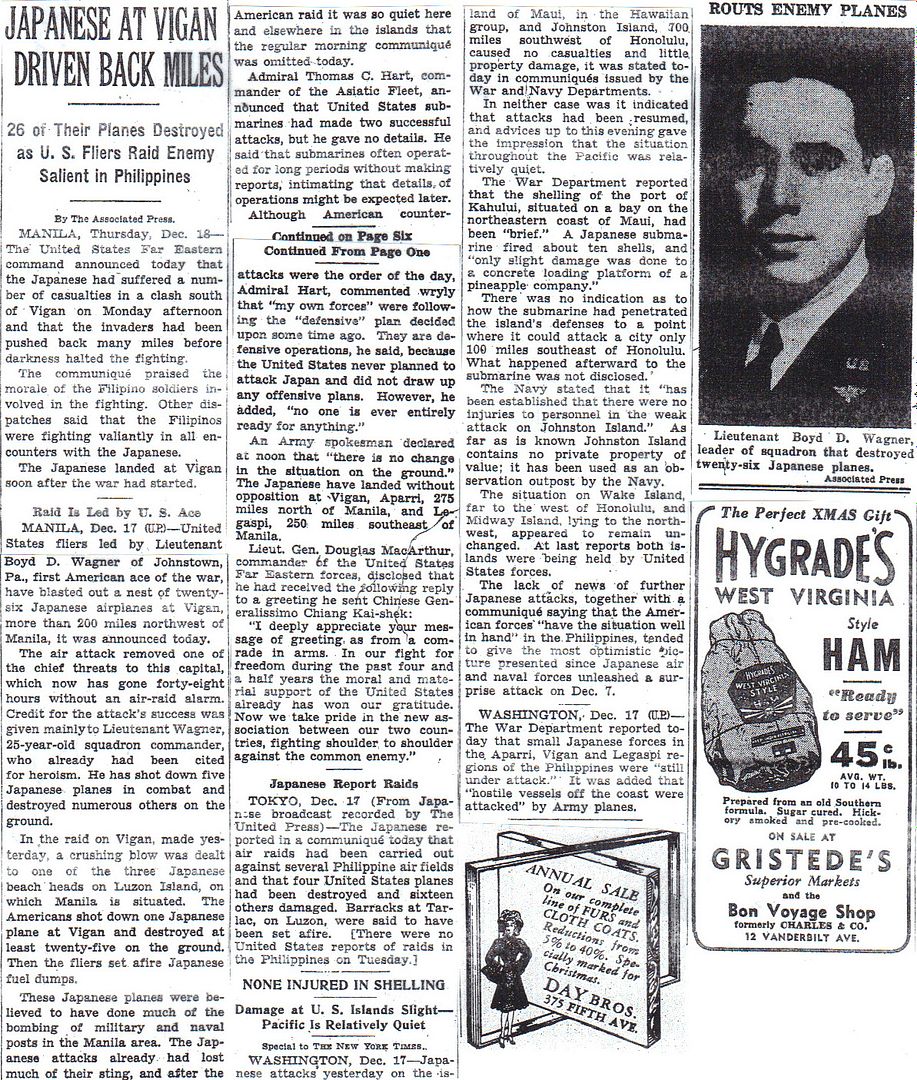
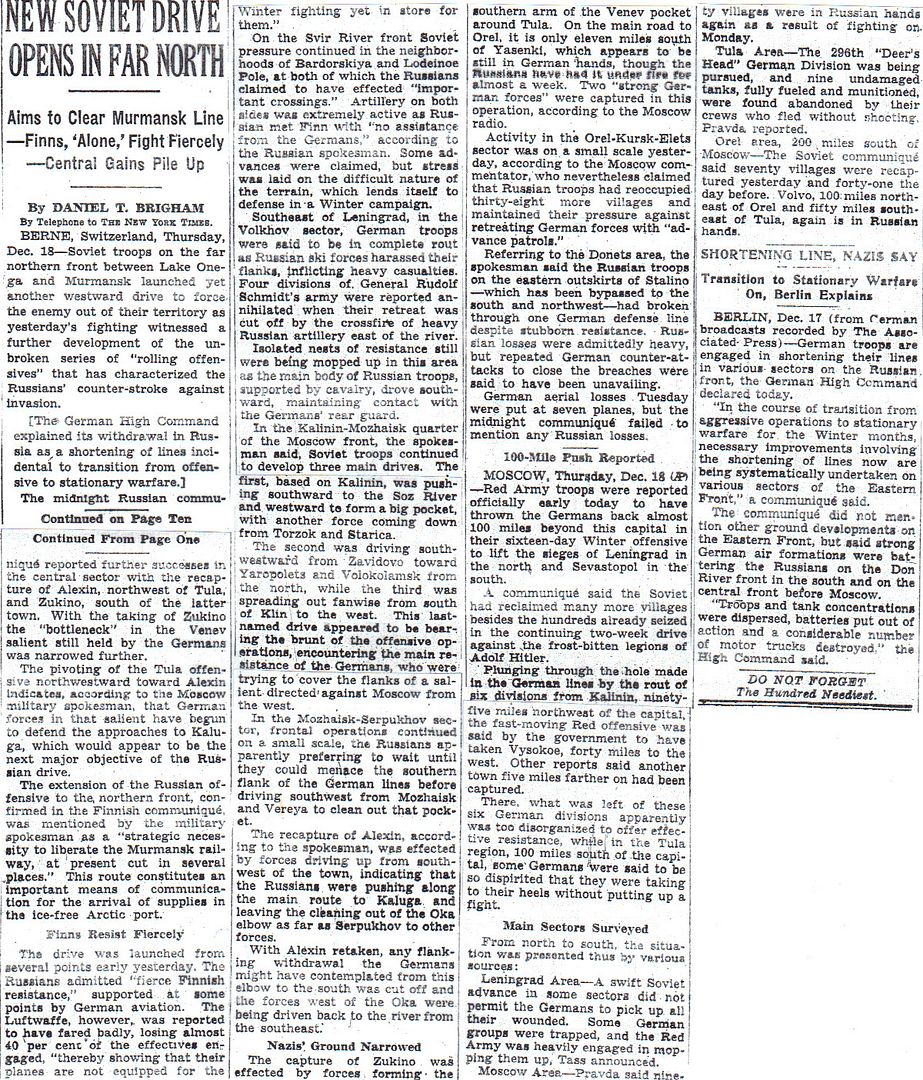
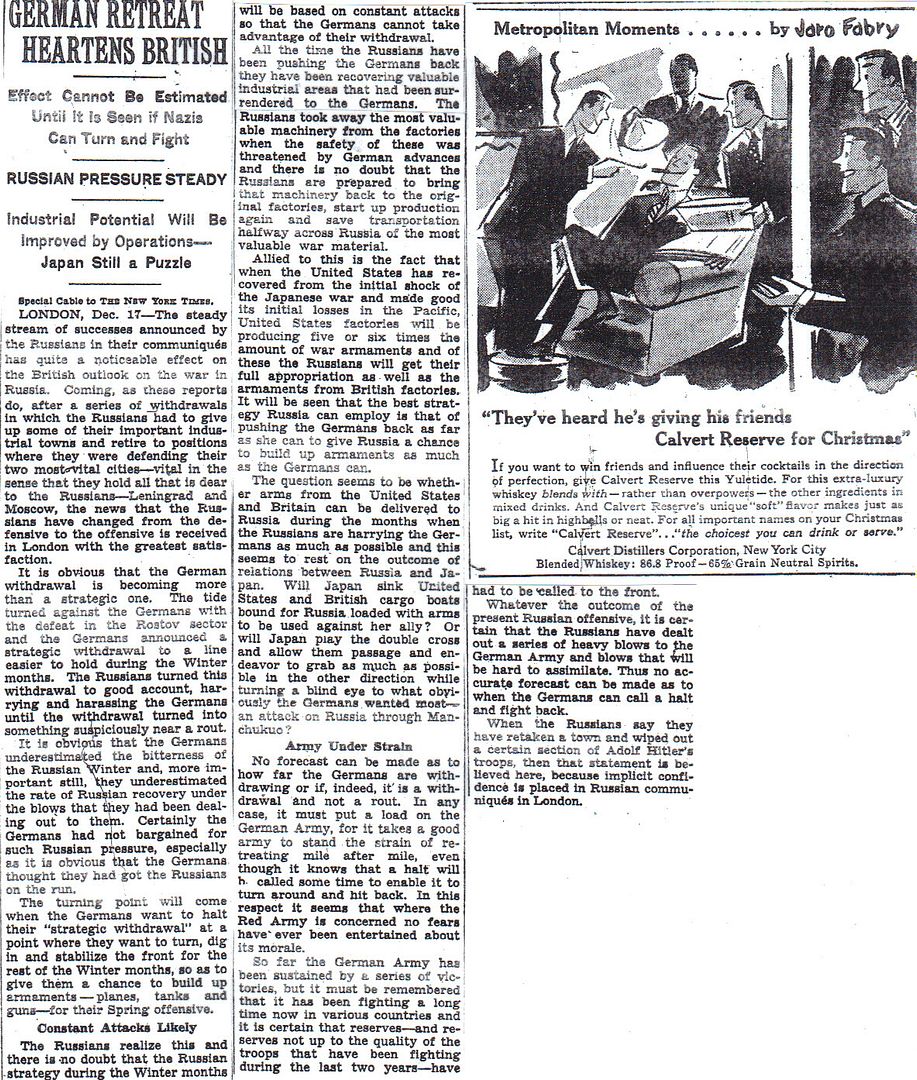
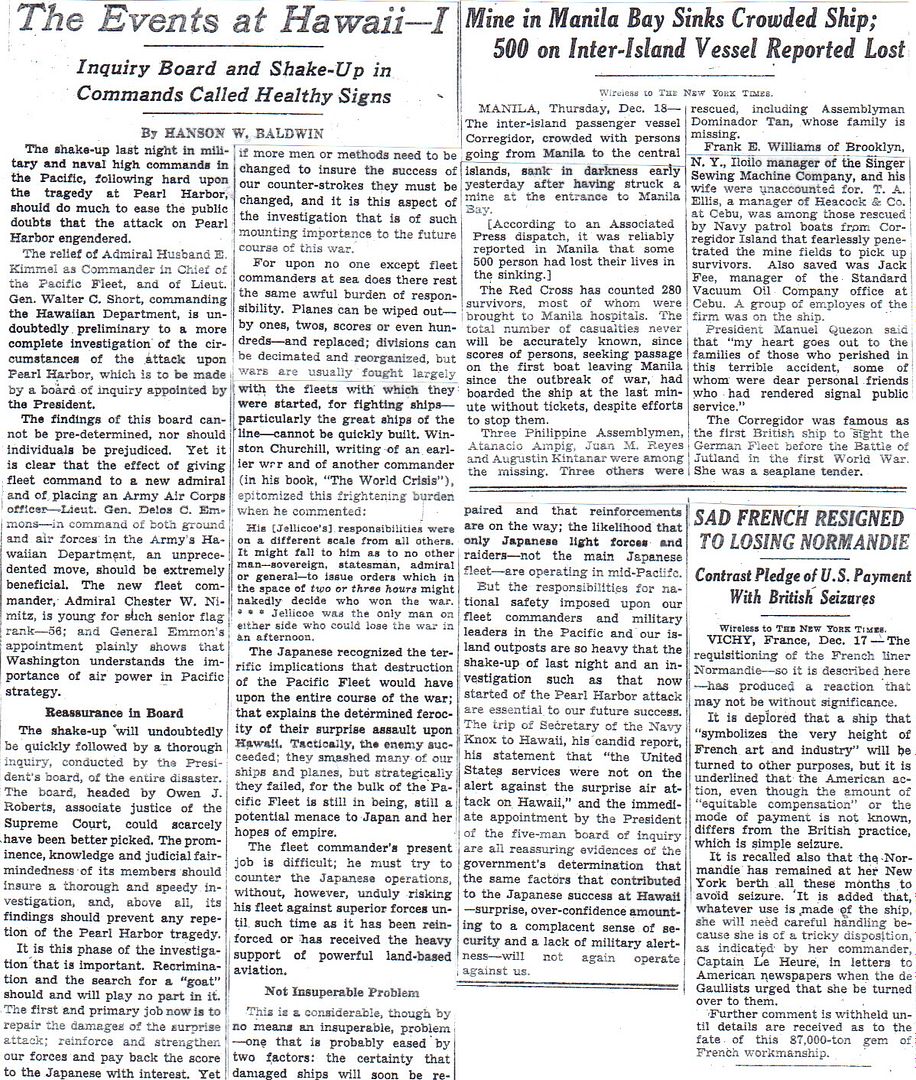
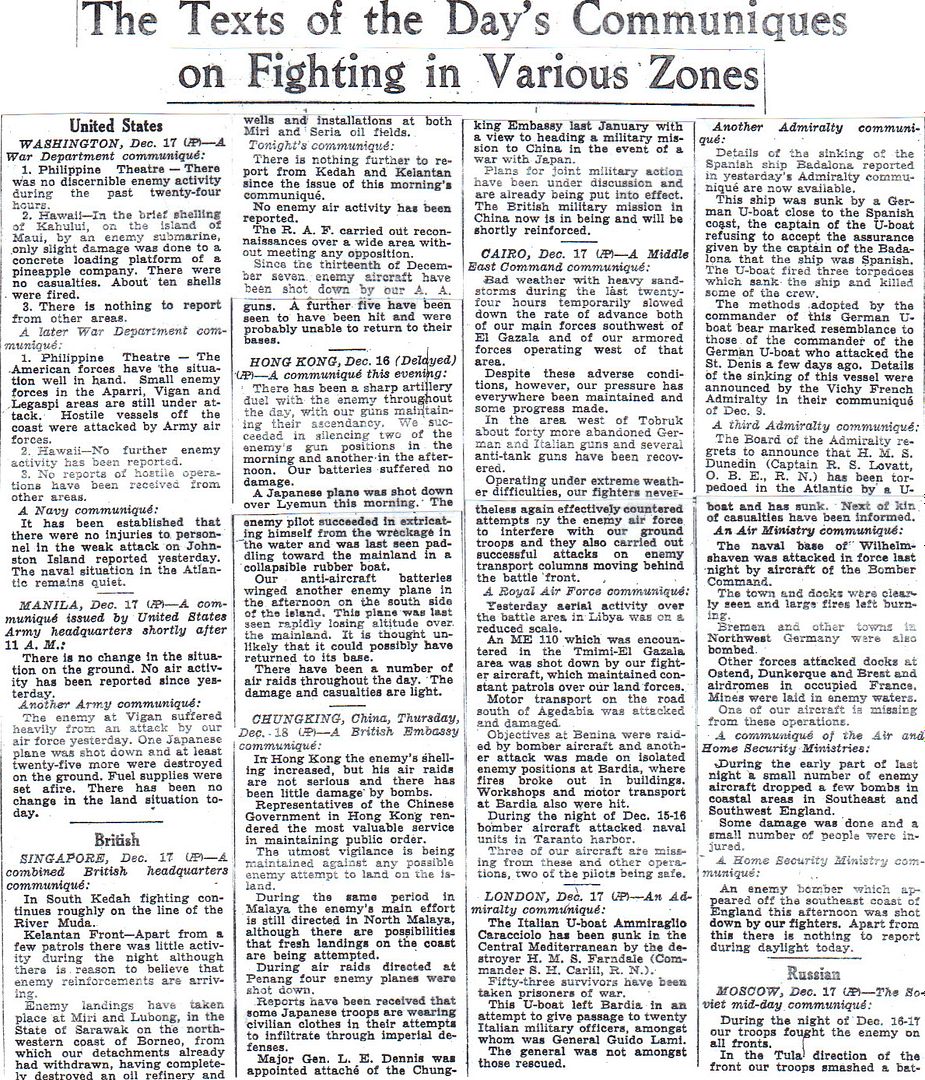
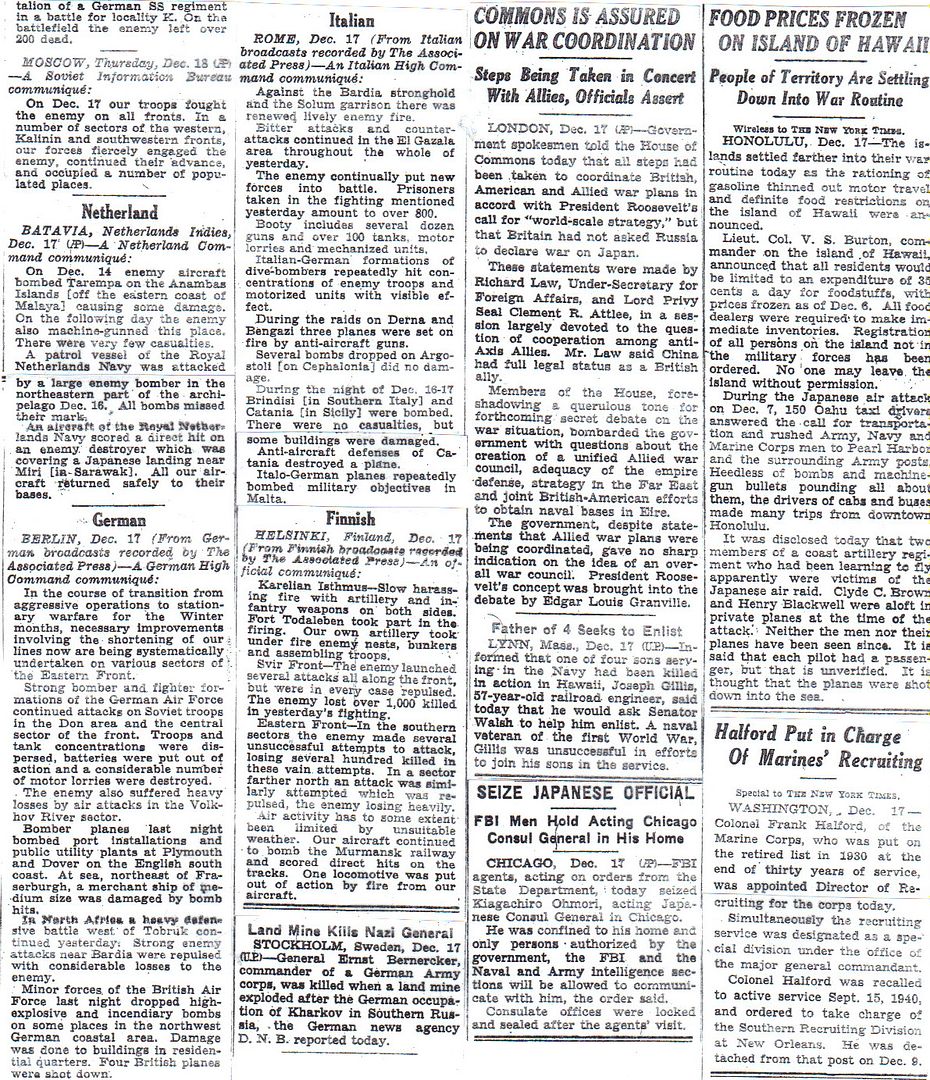
http://www.onwar.com/chrono/1941/dec41/f18dec41.htm
Hong Kong garrison fighting back
Thursday, December 18, 1941 www.onwar.com
Indian troops transporting ammunition to Hong KongIn Hong Kong... Japanese land forces during the night on Hong Kong Island between North Point and the Lei U Mun Channel. The landings are successful despite counterattacks by the undermanned British and Canadian forces on the island.
In the Mediterranean... British convoy reaches Malta with much needed supplies. Force B, part of its escort turns back to Egypt while Force K searches for the Italian convoy it engaged the day earlier. Force K runs into a mine field which sinks one destroyer and one cruiser. Both of the other cruisers are damaged. Also, Italian midget submarines penetrate the British fleet’s anchorage at Alexandria, while the net defenses have been lowered to allow Force B’s return to port. They place explosives under the battleships Queen Elizabeth and Valiant. Both sink to the bottom of the harbor. The British have lost their striking force from Malta and the Mediterranean Fleet has lost its only battleships. Coupled with the loss the American ships at Pearl Harbor and the British ships in the east, the Allies now have a serious lack of capital ships.
On the Eastern Front... Field Marshal Bock is replaced by Kluge as part of change of command due to German set backs. Like Brauchitsch, the reason given for the replacement is illness.
http://homepage.ntlworld.com/andrew.etherington/month/thismonth/18.htm
December 18th, 1941
UNITED KINGDOM:
Frigate HMS Spey launched.
Submarine HMS United launched.
Minesweeping trawlers HMS Earraid and Sir Galahad launched.
Corvette HMS Potentilla launched.
Destroyer HS Kanaris (ex-HMS Hatherleigh) launched.
(Dave Shirlaw)
GERMANY: U-707 is launched.
U-256, U-407, U-601 commissioned. (Dave Shirlaw)
MEDITERRANEAN SEA: The British convoy reaches Malta and Force B heads back for Egypt, leaving Force K to search for the Italian naval force. Ships of Force K, the British Flotilla assigned to protect Malta and its shipping, hit an Italian moored minefield 20 miles (32 kilometres) east of Tripoli, Libya. The light cruiser HMS Neptune and destroyer HMS KANDAHAR are sunk, the light cruiser HMS Aurora is badly damaged and the light cruiser HMS Penelope is slightly damaged. The sinking of HMS Neptune causes the death of 150 New Zealanders, the nation’s greatest loss at sea in World War II. The site of the stricken ships limping back to the Grand Harbour brought a sense of fear into the Maltese people, who depend on the protected convoys to survive. (Jack McKillop)
HONG KONG: The days appear to be numbered as a British colony as 40,000 Japanese troops stand by to storm and island defended by just 8,000. This evening a contingent of Japanese troops succeeded in establishing a bridgehead at Tai Koo on Hong Kong Island, after crossing the 500-yard stretch of water separating the island from the mainland and landing between North Point and the Lei U Mun Channel. The landings are successful despite counterattacks by the undermanned British and Canadian Royal Rifles of Canada. The first wave of Japanese troops land in Hong Kong with artillery fire for cover and the following order from their commander: “Take no prisoners”.
Japanese gunners, aided by superb intelligence, have targeted and destroyed pillboxes, fixed defences and air-raid shelters on the island’s North Shore. After overrunning a battery of anti-tank guns manned by local volunteers, Tanaka’s men rope together all 20 survivors of the action, and bayonet them to death. Japanese shoot and bayonet to death eight Canadians, four RAMC soldiers, and three St. John’s Ambulance men. After seizing the Lei Yu Mun Channel, the Japanese 38th Division storms across Hong Kong Island from east to west, splitting the two British defending brigades. The Japanese quickly take control of key reservoirs, threatening the British and Chinese inhabitants with a slow death by thirst. (Jack McKillop)
The Hong Kong governor, Sir Mark Young, urged on by messages from Mr Churchill, continues to reject Lt-Gen Takaishi Sakai’s offers to surrender “on the grounds of humanity.” Today Sir Mark “flatly rejected” the third such offer in five days.
inhabitants with a slow death by thirst. (Jack McKillop)
MALAYA: The Indian 11th Division completes their withdrawal behind the Krian River and is held in reserve in the Taiping area. Forces defending the Grik road are further reinforced. After visiting forward areas, Lieutenant General Sir Arthur E. Percival draws up plans for a withdrawal behind the Perak River; he also decides to amalgamate certain units, among them the Indian 6th and 15th Brigades (to be designated the Indian 6/15 Brigade) and to incorporate the Indian 12th Brigade Group in the Indian 11th Division. (Jack McKillop)
The Japanese occupy Penang which was evacuated by the British yesterday. (Jack McKillop)
All combat-worthy aircraft in Malaya are ordered to fly to Singapore. (Jack McKillop)
BORNEO: For a second day, Dutch reconnaissance aircraft from Singkawang, Borneo, make reconnaissance flights over the Japanese invasion fleet. A Dutch Dornier Do-24 bombs and sinks Japanese destroyer HIJMS Shinonome off Miri, Borneo. (Jack McKillop)
COMMONWEALTH OF THE PHILIPPINES: On Luzon, the Japanese Legaspi detachment reaches Naga. (Jack McKillop)
The French 14,000-ton motor mail vessel Marechal Joffre, manned by a scratch crew that includes aviation personnel from Patrol Wing Ten (PatWing 10), departs Manila Bay for Balikpapan, Borneo, and then to Australia, New Zealand and finally, San Francisco arriving in April 1942. Marechal Joffre will be formally acquired by the Navy and commissioned as the transport USS Rochambeau (AP-63) on 27 April 1942. (Jack McKillop)
U.S.A.: Censorship is imposed with the passage of the first American War Powers Act. The War Powers Act is passed by Congress, authorizing the president to initiate and terminate defence contracts, reconfigure government agencies for wartime priorities, and regulate the freezing of foreign assets. It also permitted him to censor all communications coming in and leaving the country. President Franklin D. Roosevelt appointed the executive news director of the Associated Press, Byron Price, as director of censorship. Although invested with the awesome power to restrict and withhold news, Price took no extreme measures, allowing news outlets and radio stations to self-censor, which they did. Most top secret information, including the construction of the atom bomb, remained just that. The most extreme use of the censorship law seems to have been the restriction of the free flow of “girlie” magazines to servicemen-including Esquire, which the Post Office considered obscene for its occasional saucy cartoons and pinups. Esquire took the Post Office to court, and after three years the Supreme Court ultimately sided with the magazine. (Jack McKillop)
In another executive order, President Roosevelt directs a commission, to be headed by retired Supreme Court Chief Justice Owen J. Roberts (Roberts Commission), to “ascertain and report the facts relating to the attack made by the Japanese armed forces upon the Territory of Hawaii on December 7, 1941...to provide bases for sound decisions whether any derelictions of duty or errors of judgment on the part of United States Army or Navy personnel contributed to such successes as were achieved by the enemy on the occasion mentioned; and if so, what these derelictions or errors were, and who were responsible therefor.” In addition to Justice Roberts, the commission’s membership includes retired Admiral William H. Standley and Rear Admiral Joseph W. Reeves; Major General Frank R. McCoy, USA (Retired) and Brigadier General Joseph T. McNarney, USA. (Jack McKillop)
An order is promulgated giving CINCUS direct operational control over the USN’s forces. (Keith Allen)
MacArthur is promoted to General. (Jack McKillop)
Destroyer USS Corry commissioned. (Dave Shirlaw)
HAITI: Port Au Prince breaks off diplomatic relations with Berlin. (Mike Yared)
CANADA:
Corvettes HMCS Halifax and Vegreville arrived Halifax from builders Montreal, Province of Quebec.
Corvette HMCS Charlottetown arrived Halifax from builder Quebec City, Province of Quebec.
1941 - Corvette HMCS Fredericton arrived Halifax from builder Sorel, Province of Quebec. (Dave Shirlaw)
U.S.A.: Destroyer USS Corry commissioned. (Dave Shirlaw)
NORTH ATLANTIC: The German submarine U-434 is sunk north of Madeira, Portugal, in position 36.15N, 15.48W, by depth charges from the British escort destroyer HMS Blankney and the destroyer HMS Stanley. 42 of the 46-man crew survive. (Jack McKillop)
General Short was 100% responsible for defense of the Naval Fleet when it was docked in Pearl Harbor, this was not Kimmel’s responsibility. Admiral Kimmel only got drawn into the defense when he volunteered to use Naval aircraft for long range search missions.
The reason for Kimmel doing this was because Washington had stripped Short of long range aircraft, which had been sent to the Philippines for MacArthur’s use (and where MacArthur let them be destroyed on the ground many hours after being informed of the attack on Pearl Harbor, and after hours of his senior air officer begging him to attack the Jap airfields on Formosa).
Kimmel would have been better off career-wise to have refused to use his aircraft to help out General Short, but Kimmel was a diligent officer who was concerned with the defense of the fleet. Even so, Kimmel didn’t have nearly enough aircraft to do a full search around Hawaii, and when the Jap planes came in from slightly northeast of Pearl, they were only detected by one of Short’s radar units.
Kimmel and Short actually demanded Courts Martial, which was their right, so all the facts would come out, but the requests were ignored and they were pressured into retiring. In Kimmel’s case it was particularly sad, because he had been an outstanding Naval officer who had been very diligent in everything he did.
I'm not so sympathetic to General Short and the US Army. Why did the army have an infantry general commanding? It's because they court martialed Billy Mitchell years before. Had an air force officer been in charge, the planes would have been fully armed and fueled and they would have been dispersed. It's quite likely RADAR would have been more effectively used as well.
General Short thinking like an infantry officer, thought that the greatest threat was from sabotage, so he had the aircraft parked close together unarmed and unfueled, so they could be easier to protect from saboteurs. Billy Mitchell predicted the attack on Pear Harbor. Had he not been run off, the commander of the air bases in the Hawaiian islands would have been an air force officer trained by Billy Mitchell.
Agreed, while Kimmel was in my opinion partially responsible in that his ships should have kept on a war footing, just in case, he at least was trying. He was very aggressive on ASW issues, to prevent a sub from getting into Pearl the way Gunther Prien was able to get into Scapa Flow and sink HMS Royal Oak.
Short on the other hand simply did not even try to prepare for any sort of air attack. The radars should have been manned 24/7, the same with the plotting center, he should have dispersed his aircraft, kept a Combat Air Patrol aloft and had additional fighters on alert for immediate take off. Even if the chance of air attack on Hawaii is remote, it would have been good training. And it was simply a matter of time before those pilots would be going into combat.
MacArthur and Brereton I have ranted on before, they both should have lost their jobs on December 8th. Heck MacArthur should have cashiered by President Hoover for insubordination during the Bonus Army incident. It would have saved thousands of American and Filipino lives and cost the Japanese dearly in the Philippines.
Had I been making the decisions i would have done the following:
Kimmel, demotion and a staff job.
Short and MacArthur, court martial,
Brereton, demotion to colonel, sent to a training command where he can’t hurt too many people with hair brained schemes.
Hart, I would have placed in command of the Southwest Pacific, he did the best with what he had of all the pre-war commanders.
Its not a revisionist writing in the usual sense, there's no speculation or sketchy 'seaman x' sources - the material all comes from the record and puts very much in perspective how unfairly Kimmel and Short were treated by their superiors and FDR following the attack.
If the area commanders had been kept informed up to the minute of how critical the situation was becoming, and that DC KNEW attack was coming, somewhere, hours before it did, Short would have had the opportunity to take these measures. But the last war warning he had received from Washington was in late November, and he hadn't the resources to stay on a total war footing indefinitely.
Washington - Stark, Marshall, Turner, ultimately FDR, etc were at least as much responsible for the disaster but paid no price at all.
This particular part of your argument is totally false.
As demonstrated here, Kimmel was fully aware of Japan's capability of attacking Hawaii.
The issue was whether they had any intention to do so, and the answer from every intelligence report Kimmel received was "no".
So Kimmel's major malfunction was that he believed what his intelligence services and Washington superiors told him.
Shame on him for that, but what about shame on them, if they actually knew or suspected more than they told Kimmel?
So why did you leave out the key part of that quote?
"To this Kimmel responded 'Why are you so worried about this? Do you think we are in danger of attack?'
To which Mollison replied 'The Japanese have such a capability.'
'Capability, yes, but possibility?' asked Kimmel.
Immediately he asked the fleet war plans officer, Captain Charles McMorris, "What do you think about the prospects of a Japanese air attack?"McMorris replied 'None, absolutely none.' "
Pal, I think you're not grasping the basic concept here: Kimmel and others fully understood that the Japanese could launch an attack on Hawaii.
What they lacked was any DATA from US intelligence or Washington higher-ups telling them it was even likely the Japanese would launch such attack.
Of course the failure was Kimmel's, but it was everyone else's too, from President Roosevelt all the way down.
None considered an attack on Hawaii likely.
Or so they all claimed after the fact.
Certainly none issued warnings to Hawaii of expected Japanese air attack there.
The question then for historians is: whether anyone in that chain of command had received data which could have revealed Hawaii as a Japanese target, and if so, why were appropriate warnings not passed to the commanders there?
There was ample evidence from the Purple intercepts - the 'bomb plot' message, the constant requests to the Japanese attache in Honolulu for data on US ships' comings & goings.
None of which was passed to the area commanders.
Interesting choice. Personally, though I think Billy Mitchell would have been an upgrade over Short, I would rather have had Charles Chennault (since we are looking at Army “air” commanders). I don’t know if we will see much reporting on his work against the Japanese in China in the Times, but the AVG is already making a name for itself now over in China and I think a fighter general would have been a better choice than a bomber general. At any rate I think we both are thinking that whoever was in charge at Pearl would have been better served if he was “air” minded, which Short clearly was not.
You also seem to be failing to grasp the basic concept here.
Commanders like Kimmel believed the Japanese were capable of attacking Hawaii.
What they lacked was D A T A telling them such an attack was coming, or even likely.
Instead, the data they had showed the Japanese attacking the Philippines and other Southeast Asia positions.
So the question for historians is, did anyone in the US military suspect an attack on Hawaii, and if so, why were the commanders there not better warned?
So Short had no long range aircraft? From where do you get this information? To whom did these I see here sitting on the ground at Ford Island belong to?
Let's see, among other aircraft sitting on the ground, I see a relatively intact PBY and to the right what looks like an OS2U Kingfisher floatplane. Farther to the right I might see a Curtis SOC scoutplane. The Curtis SOC was a bi-winged floatplane. Other candidates for that highwinged craft might have been the O-38 or O-52 (both the O-38 and O-52 observation planes had high wings). I can't tell what type aircraft the empennage at far right belongs to.
Laying on the ground next to the two stunned sailors is the wrecked wing of a PBY. All long range observation aircraft sitting on the ground in just one photo of one airfield at Pearl Harbor. If these didn't belong to Short, who did they belong to and why were they sitting on the ground?

Which long range aircraft are you referring to as having been stripped from Hawaii and sent to the Philippines?
Disclaimer: Opinions posted on Free Republic are those of the individual posters and do not necessarily represent the opinion of Free Republic or its management. All materials posted herein are protected by copyright law and the exemption for fair use of copyrighted works.